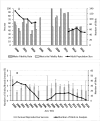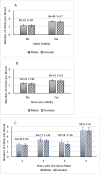Influence of mate and nest-site fidelity on a declining, urban avian population
- PMID: 40560918
- PMCID: PMC12192075
- DOI: 10.1371/journal.pone.0326160
Influence of mate and nest-site fidelity on a declining, urban avian population
Abstract
As urbanization reduces species' habitats and population sizes, managers need information on whether within-population processes, such as changes in mate and nest-site fidelity and dispersal distances, may be contributing to declines. Few avian studies have examined changes in these behaviors in declining populations or in urban settings. We investigated whether mate fidelity, nest-site fidelity or breeding dispersal distance changed over time in a population of burrowing owls (Athene cunicularia), a short-lived, socially-monogamous species. During the 18-year period of the study, the population declined by 69% in urban Santa Clara County, California, USA--a region of rapid urbanization. We assessed whether these behaviors were influenced by key factors including age, breeding success in the previous year, and years with the same mate, and examined the relationship between mate and nest-site fidelity over time and annual reproductive success. Our analyses showed no change over time in mate fidelity rates, nest-site fidelity rates, dispersal distances or annual reproductive success, indicating these behaviors remained stable even during a severe population decline. Although burrowing owls are a short-lived species, we found that increasing years with the same mate resulted in increased nest-site fidelity and annual reproductive success. To achieve increasing annual reproductive success in this species and others with similar fidelity behaviors, nest sites and pairs must be protected over many years allowing mates to stay together in the same nest territory. Since these fidelity behaviors were maintained during the population decline, other factors require investigation to determine the causes for decreases in this population. Burrowing owls are an urban-adaptable species that can maintain important fidelity behaviors in human-altered habitats. However, even such species are subject to population declines in urban settings.
Copyright: © 2025 Trulio et al. This is an open access article distributed under the terms of the Creative Commons Attribution License, which permits unrestricted use, distribution, and reproduction in any medium, provided the original author and source are credited.
Conflict of interest statement
The authors have declared that no competing interests exist.
Figures




Similar articles
-
Cost-effectiveness of using prognostic information to select women with breast cancer for adjuvant systemic therapy.Health Technol Assess. 2006 Sep;10(34):iii-iv, ix-xi, 1-204. doi: 10.3310/hta10340. Health Technol Assess. 2006. PMID: 16959170
-
Behavioral interventions to reduce risk for sexual transmission of HIV among men who have sex with men.Cochrane Database Syst Rev. 2008 Jul 16;(3):CD001230. doi: 10.1002/14651858.CD001230.pub2. Cochrane Database Syst Rev. 2008. PMID: 18646068
-
Drugs for preventing postoperative nausea and vomiting in adults after general anaesthesia: a network meta-analysis.Cochrane Database Syst Rev. 2020 Oct 19;10(10):CD012859. doi: 10.1002/14651858.CD012859.pub2. Cochrane Database Syst Rev. 2020. PMID: 33075160 Free PMC article.
-
Factors that influence parents' and informal caregivers' views and practices regarding routine childhood vaccination: a qualitative evidence synthesis.Cochrane Database Syst Rev. 2021 Oct 27;10(10):CD013265. doi: 10.1002/14651858.CD013265.pub2. Cochrane Database Syst Rev. 2021. PMID: 34706066 Free PMC article.
-
Shared decision-making interventions for people with mental health conditions.Cochrane Database Syst Rev. 2022 Nov 11;11(11):CD007297. doi: 10.1002/14651858.CD007297.pub3. Cochrane Database Syst Rev. 2022. PMID: 36367232 Free PMC article.
References
-
- Angel S, Parent J, Civco DL, Blei A, Potere D. The dimensions of global urban expansion: estimates and projections for all countries, 2000–2050. Progress Planning. 2011;75(2):53–107. doi: 10.1016/j.progress.2011.04.001 - DOI
-
- Fuirst M, Strickland D, Norris DR. Patterns and causes of breeding dispersal in a declining population of Canada jays, Perisoreus canadensis, over 55 years. Animal Behaviour. 2021;182:31–41. doi: 10.1016/j.anbehav.2021.09.015 - DOI
MeSH terms
LinkOut - more resources
Full Text Sources
Research Materials

